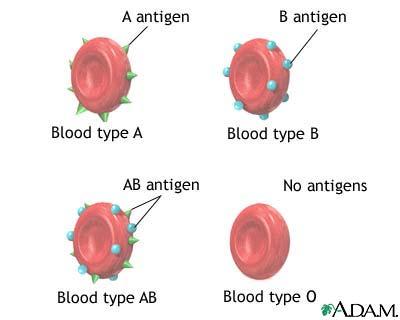I’m A, Rh+. Most of us are O, Rh+. Figured it out yet? I’m talking about our blood. As a regular blood donor I have learned about blood types and who I can give blood to and who I can’t. But for most of us who are not donors this remains a mystery. Well it turns out that even I as a donor only know half the story and it’s an interesting one.
Our human population globally shares 4 major blood types. In some countries these types are referred to with different classifications (in Russia, for example, they are referred to as 1, 2, 3 and 4) but generally through most of the world they are defined as A, B, AB and O. Blood that is classified as A contains an antigen or protein that makes it compatible only with other people with A or AB blood types. Blood that is classified as B contains another antigen that works only with B and AB blood types. Those with AB blood contain two antigens that makes it possible only to receive blood from another with AB blood. Those with O blood have no antigen and can therefore be compatible with any other blood type. When blood isn’t properly type matched the presence of an antigen can lead to a dangerous reaction in the person receiving the blood.
Rhesus monkeys share many of our biological characteristics. The Rh protein is named after them and when present in blood is referred to as a positive, or Rh+. The absence of Rh protein is negative or Rh-. So all blood types are a combination of these four different types plus the existence or non-existence of Rhesus proteins. Hence we have A+, A-, B+, B-, AB+, AB-, O+ and O-. This has been our general understanding of the major blood groups since Karl Landsteiner, an Austrian, first made the discovery in the 1890s, and since our discovery of the Rhesus protein in the first half of the 20th century.

But the science of blood typing has led to further refinements since the mid-20th century and up until a few months ago we had identified 30 variable proteins. Some of these go by such interesting names as Duffy, Kidd, Diego and Lutheran. Now we can add two more named Langereis (Lan for short) and Junior discovered by the combined work of researchers at the Japanese Red Cross Osaka and Hokkaido Blood Centers, the University of Vermont and the French National Institute for Blood Transfusion in Paris. Right now both of these new blood group proteins are considered very rare but with their identification routine screening for the proteins can become a global standard.
Matching blood proteins is extremely important for ensuring successful organ transplants. Any one of these blood proteins in the donor could, if incompatible with the recipient, lead to organ rejection as the body automatically creates antibodies to defend against what is seen as a foreign invader.
Currently populations most susceptible can be found in Japan and among European Roma who are at higher risk because they do not have the Lan and Junior proteins. Scientists believe there are more unknown blood types, as many as 10 to 15, still to be discovered.















Russia are said to use Jan Jansky’s classification for blood types (using figures or roman numerals). Can you please tell me whether or not the letters Rh are used in Russia, and, if so, when did Russia begin to use Rh?
With thanks.
Russia uses 0,I, II, and III to define blood types. I cannot find a reference to a Russian alternate designation for Rh factors.